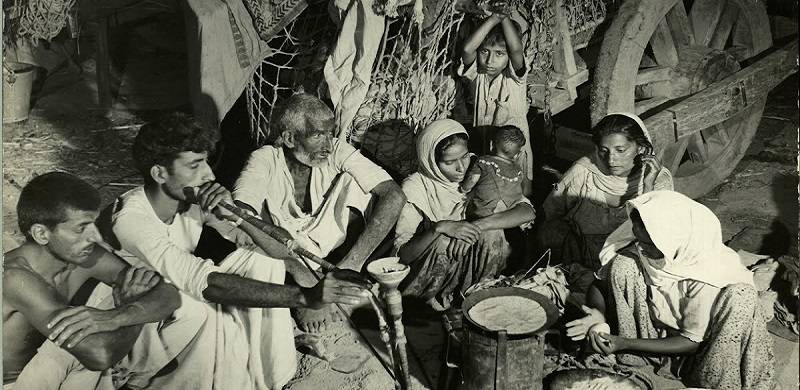
The creation of India and Pakistan lead to one of the biggest exoduses and one of the bloodiest migrations in the human history. About 14 million people abandoned their homes in 1947, when the British colonialists commenced their exit from South Asia.
The carnage consumed innocents souls numbering anywhere between 200,000 and 2 million. Trains carrying refugees between the two new nations arrived full of mutilated bodies of children, women and elderly.
Mass rape and murder spared not even children. Women, in particular, were engulfed in the mayhem that followed independence, burnt by their own families to protect “family honour” - if they escaped rape by men of the opposite religion. For thousands of women, life simply became living hell.
Abductions by the rival sides of communal murderers only added to the misery of women. Some estimates put the number of women who had been missing at 10 times the official figure.
The misery of missing women was supposed to be put to an end by the Abducted Persons (Recovery and Restoration) Act. Undoubtedly, many women were recovered with an effort from both the governments. 20,000 Muslim women were recovered: some married, with children, which aggravated their already precarious circumstances.
Unwilling to leave their children behind, rejected by their own families, their crisis only worsened. The State assumed the role of a parent patriarch and relocated the women that were forcibly abducted. And so, a forcible abduction ended with a forcible recovery.
As stated previously, there were two forms of violence against women during Partition.
The first form was violence inflicted on women by men of the rival religious group.
The second type of violence against women was perpetuated by women’s own male kin for protecting families' honour, by means of poison, strangulation, burning to death or drowning.
The most common ways in which this type of violence was manifested on female bodies included mutilation or branding of genitalia with religious symbols, ripping out their wombs, being paraded naked on the streets or in places of religious worship, and finally, rape.
The violent acts on women’s bodies were a way to send out a threat to the men of the religious group to which the women belonged.
A woman’s body became a symbolic site where one group tried to prove its religious supremacy over the other.
Thus the female body in communal conflict became a symbol of torture.
Usually, rape and sexual assault were invariably followed by abduction of the victimized women.
Abducted women were forced to work as domestic servants and sex slaves and sold into prostitution and some, in very rare instances, were forced to marry their abductors.
12,500 Muslim women were recovered from India by late 1949. Unfortunately, many of these were rescued children, later abandoned at orphanages. Many expecting mothers underwent (illegal) abortions.
The women were considered martyrs who had sacrificed themselves to safeguard their families.
More than seven decades after independence, the women of our country are still being immolated: burning at home at the hands of her kin and beyond the four walls at the hands of social taboos.
The carnage consumed innocents souls numbering anywhere between 200,000 and 2 million. Trains carrying refugees between the two new nations arrived full of mutilated bodies of children, women and elderly.
Mass rape and murder spared not even children. Women, in particular, were engulfed in the mayhem that followed independence, burnt by their own families to protect “family honour” - if they escaped rape by men of the opposite religion. For thousands of women, life simply became living hell.
Abductions by the rival sides of communal murderers only added to the misery of women. Some estimates put the number of women who had been missing at 10 times the official figure.
The misery of missing women was supposed to be put to an end by the Abducted Persons (Recovery and Restoration) Act. Undoubtedly, many women were recovered with an effort from both the governments. 20,000 Muslim women were recovered: some married, with children, which aggravated their already precarious circumstances.
Unwilling to leave their children behind, rejected by their own families, their crisis only worsened. The State assumed the role of a parent patriarch and relocated the women that were forcibly abducted. And so, a forcible abduction ended with a forcible recovery.
As stated previously, there were two forms of violence against women during Partition.
The first form was violence inflicted on women by men of the rival religious group.
The second type of violence against women was perpetuated by women’s own male kin for protecting families' honour, by means of poison, strangulation, burning to death or drowning.
The most common ways in which this type of violence was manifested on female bodies included mutilation or branding of genitalia with religious symbols, ripping out their wombs, being paraded naked on the streets or in places of religious worship, and finally, rape.
The violent acts on women’s bodies were a way to send out a threat to the men of the religious group to which the women belonged.
A woman’s body became a symbolic site where one group tried to prove its religious supremacy over the other.
Thus the female body in communal conflict became a symbol of torture.
Usually, rape and sexual assault were invariably followed by abduction of the victimized women.
Abducted women were forced to work as domestic servants and sex slaves and sold into prostitution and some, in very rare instances, were forced to marry their abductors.
12,500 Muslim women were recovered from India by late 1949. Unfortunately, many of these were rescued children, later abandoned at orphanages. Many expecting mothers underwent (illegal) abortions.
The women were considered martyrs who had sacrificed themselves to safeguard their families.
More than seven decades after independence, the women of our country are still being immolated: burning at home at the hands of her kin and beyond the four walls at the hands of social taboos.
